Qatar is a small country in the Middle East, but it is home to a large variety of birds. With its vast deserts, stunning coastline, and man-made wetlands, Qatar is a birdwatcher’s paradise.
From the impressive raptors of the desert to the colorful larks of the beaches, Qatar is home to some of the most beautiful and fascinating birds in the world.
1. Bustard
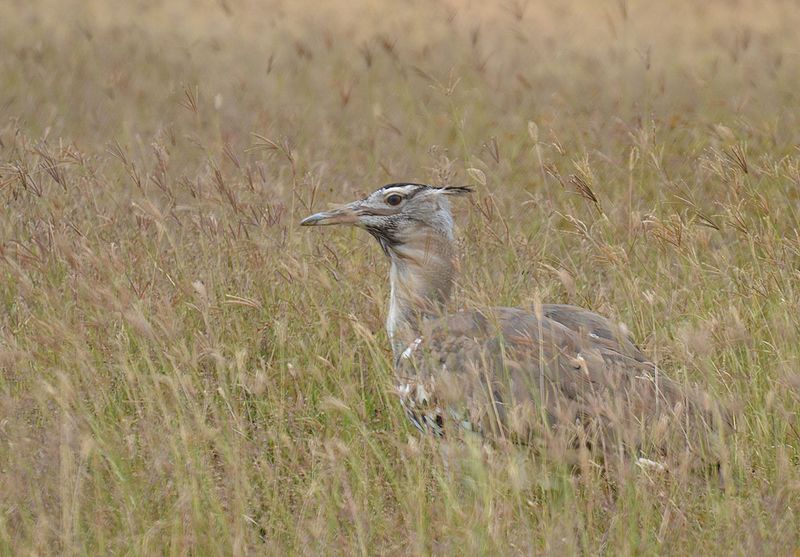
Bustards are large, terrestrial birds that inhabit dry grassland areas and the steppes of the Old World. They range from 40-150 cm in length and belong to the family Otididae.
Bustards have an omnivorous diet consisting of leaves, buds, seeds, fruit as well as small vertebrates and invertebrates.
These birds usually live a solitary life but can be seen gathering around water sources or food during certain times of year such as mating season.
Due to their large size they are vulnerable to predation by foxes or other animals which is why they tend to remain alert at all times.
When in open spaces while relying on camouflage for protection against predators when out in tall vegetation coverings.Scientific classification:
| Kingdom | Animalia |
| Phylum | Chordata |
| Class | Aves |
| Clade | Otidimorphae |
| Order | Otidiformes Wagler, 1830 |
| Family | Otididae Rafinesque, 1815 |
2. Skuas
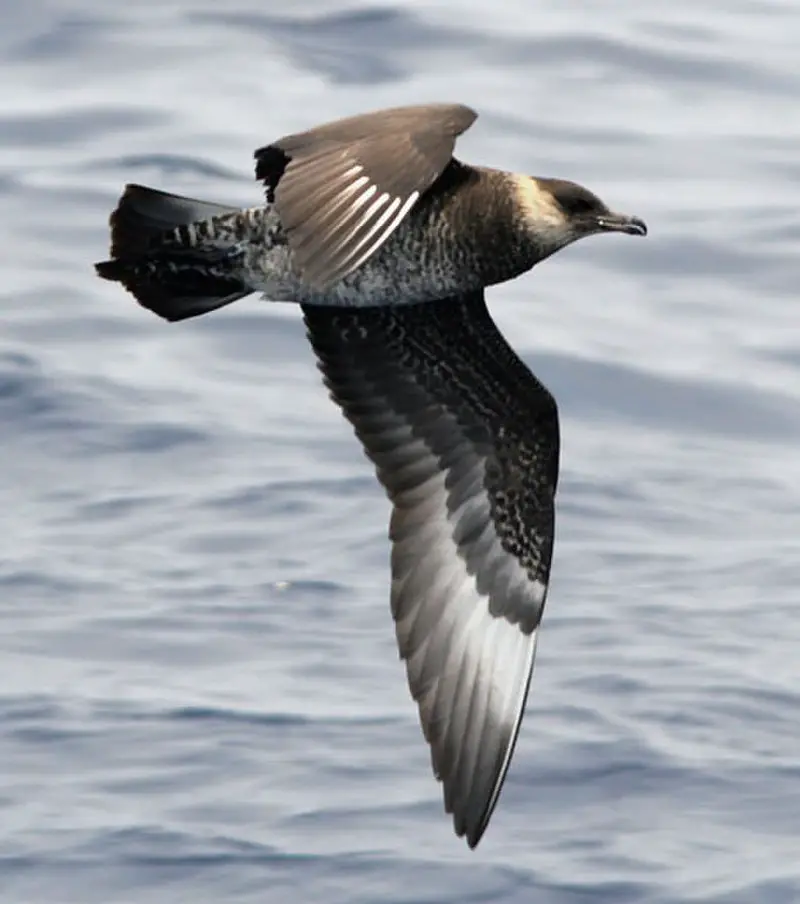
Skuas are a group of predatory seabirds with seven species, all belonging to the genus Stercorarius.
They are also known as “Jaegers” in North America and their name originates from the Faroese word for Great Skua – skúgvur.
These birds typically inhabit coastal areas or open oceans where they feed on fish, krill and other marine creatures.
Skuas can be distinguished by their pointed wings which help them fly long distances while hunting food.
Their distinctive colouration varies depending on age and habitat but generally includes greyish brown upperparts and white underparts with black streaks along its belly area.
The overall size ranges from 24-40 cm making these one of the larger sea bird species.Scientific classification:
| Kingdom | Animalia |
| Phylum | Chordata |
| Class | Aves |
| Order | Charadriiformes |
| Suborder | Lari |
| Family | Stercorariidae Gray, 1871 |
| Genus | Stercorarius Brisson, 1760 |
3. Glareolidae
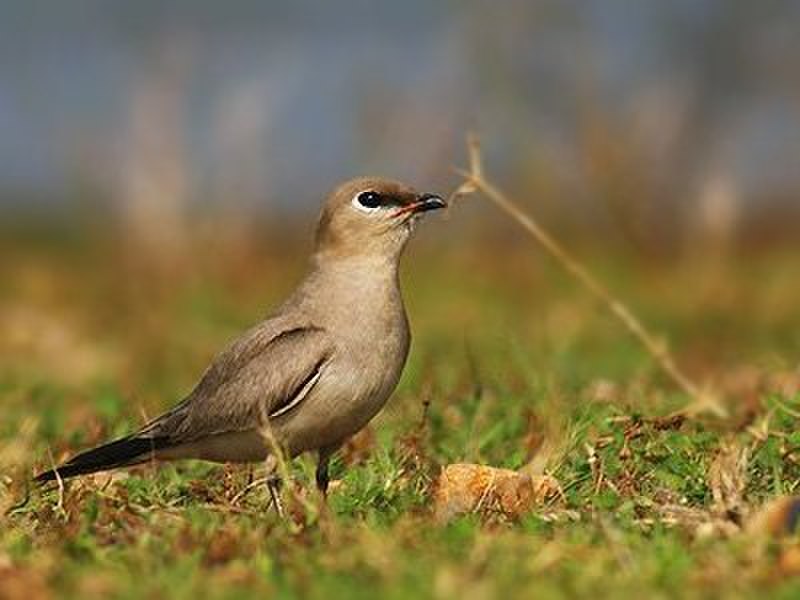
Glareolidae is a family of wading birds, consisting of four genera and 17 species. They are distinguished from other charadrii by their long bills which have a slight downward curve.
Glareolidae live around open grasslands and deserts, where they hunt for insects using the bill to probe into soil or vegetation.
Most species are found in Africa but two pratincoles inhabit parts of Europe and Asia as well.
Coursers tend to be larger than pratincoles with longer legs allowing them to run quickly across sandy dunes while feeding on small animals like lizards or spiders.
Pratincoles feed mainly on flying insects, snatching them out of midair with great agility during flight.
All glareolids share unique features such as large eyes that help it spot prey at night easily making this group one interesting bird family.Scientific classification:
| Kingdom | Animalia |
| Phylum | Chordata |
| Class | Aves |
| Order | Charadriiformes |
| Suborder | Lari |
| Family | Glareolidae CL Brehm, 1831 |
4. Pin-Tailed Snipe
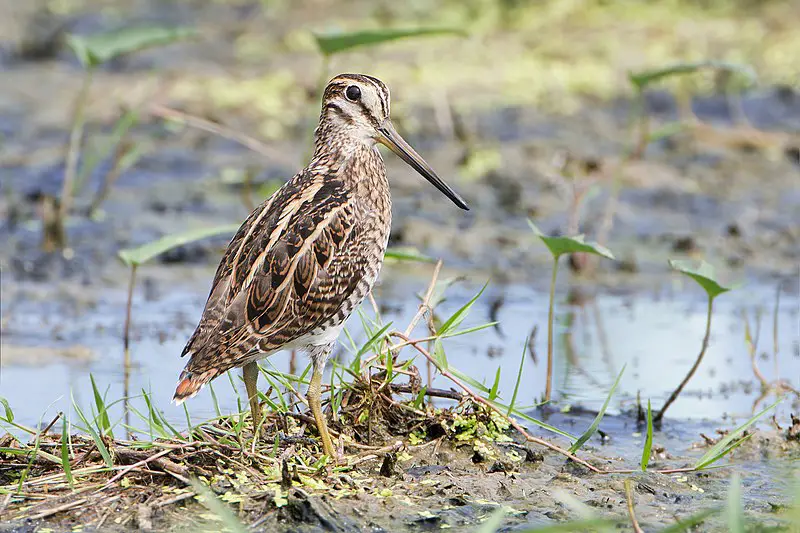
The Pin-tailed Snipe is a species of bird belonging to the family Scolopacidae. It breeds in northern Russia and migrates south during non-breeding seasons, travelling as far as Pakistan, Indonesia and even Australia.
This remarkable little bird has adapted well to its environment; it prefers wetland habitats such as marshes for breeding season and open grassy areas with low vegetation when migrating.
Its diet consists mainly of insects, worms and molluscs which are found on or near the ground amongst dense vegetation.
The pin-tailed snipe’s plumage helps camouflage it from predators while searching for food along damp grounds.
All in all this small yet resilient creature is an amazing example of evolution at work.Scientific classification:
| Kingdom | Animalia |
| Phylum | Chordata |
| Class | Aves |
| Order | Charadriiformes |
| Family | Scolopacidae |
| Genus | Gallinago |
| Species | G. stenura |
5. Greater Sand Plover
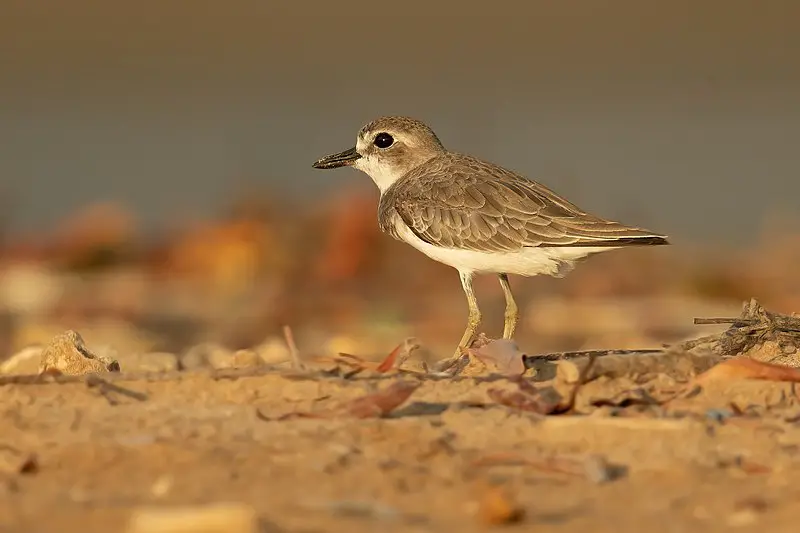
The Greater Sand Plover is a small wader, belonging to the plover family of birds. It’s scientific name Charadrius leschenaultii comes from the Latin word for a yellowish bird mentioned in the 4th century Vulgate.
These birds are typically found along coasts and sandy beaches where they feed on insects, mollusks and crustaceans.
They have grey-brown upperparts with white underparts and characteristic black bands across their chest as well as a prominent white forehead patch.
The Greater Sand Plovers breed mainly in India, Southeast Asia, Northern Australia and New Guinea while migrating to wintering grounds at coasts around South East Asia during nonbreeding season.
This species relies heavily on coastal wetlands so it is essential that these habitats be preserved in order for this species to survive into future generations.Scientific classification:
| Kingdom | Animalia |
| Phylum | Chordata |
| Class | Aves |
| Order | Charadriiformes |
| Family | Charadriidae |
| Genus | Charadrius |
| Species | C. leschenaultii |
Also Featured In: Birds of Goa, Common Birds of Maharashtra
6. White-Cheeked Tern
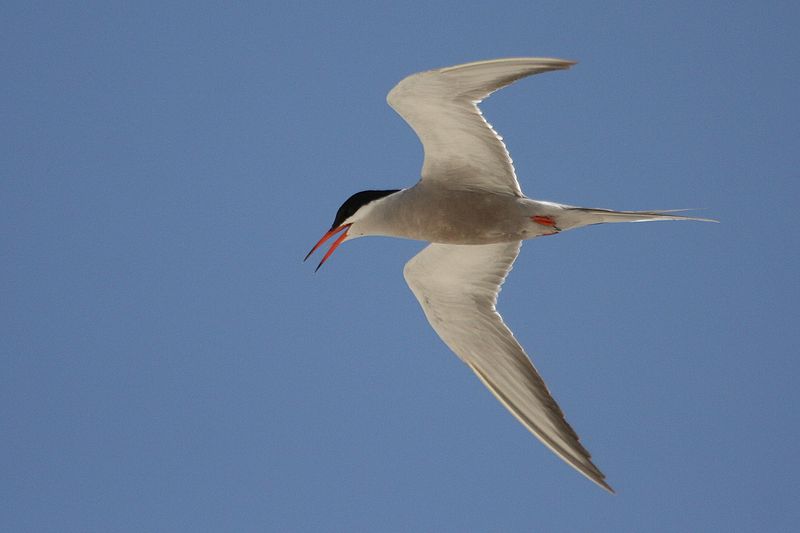
White-cheeked terns are a species of sea birds found along the coasts on the Red Sea, Horn of Africa to Kenya and Persian Gulf. They migrate during winter season with colonies ranging from 10 to 200 pairs.
These birds have white cheeks and grey upperparts which contrast against their black cap, wings and tail feathers.
In addition they possess long pointed bills making them excellent hunters for fish in both fresh or salt water habitats.
Generally solitary outside breeding times they feed using plunge dives into the water while airborne or even swimming if necessary.
During nesting time these terns become more social as parents share incubation duties before fledging young once hatched successfully.Scientific classification:
| Kingdom | Animalia |
| Phylum | Chordata |
| Class | Aves |
| Order | Charadriiformes |
| Family | Laridae |
| Genus | Sterna |
| Species | S. repressa |
7. Spur-Winged Lapwing

The Spur-winged Lapwing is a species of wader found in the family Charadriidae.
It breeds around the eastern Mediterranean and Africa, where it inhabits savannahs, wetlands and grasslands.
Its plumage is mainly black with white wing stripes and yellow legs.
This bird has an impressive crest on its head that gives it a distinctive look amongst other lapwings.
The most interesting feature of this bird though is the spurs on its wings which are believed to be part of an unattested cleaning symbiosis between them and Nile crocodiles.
It feeds mostly on insects, larvae, worms as well as some plant material such as seeds or fruits.
Overall these birds can live up to 15 years in their natural habitat making them one of longest lived among all wading species.Scientific classification:
| Kingdom | Animalia |
| Phylum | Chordata |
| Class | Aves |
| Order | Charadriiformes |
| Family | Charadriidae |
| Genus | Vanellus |
| Species | V. spinosus |
8. White-Tailed Lapwing
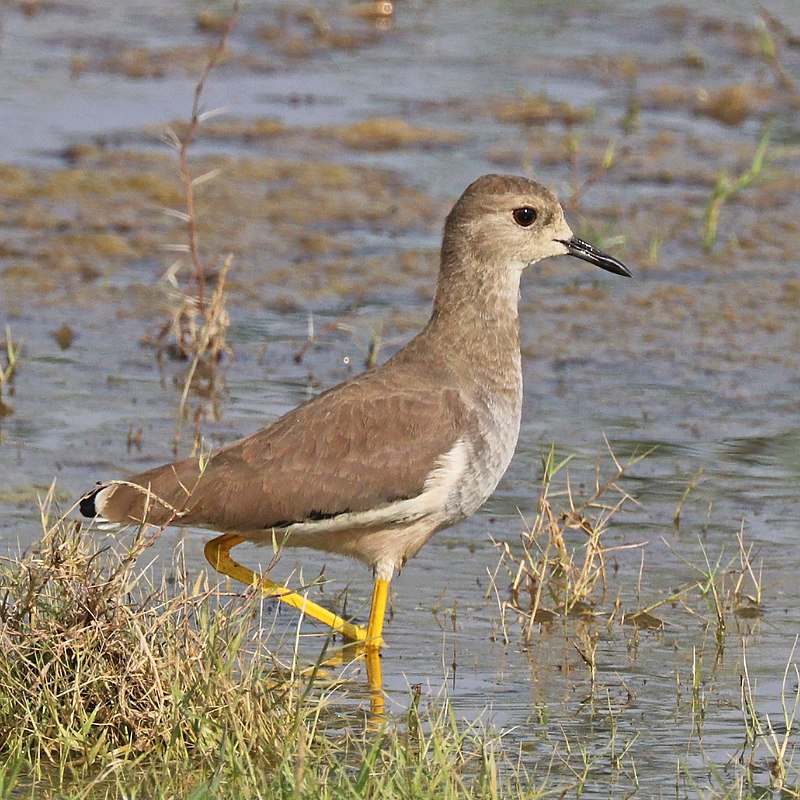
The White-tailed Lapwing is a stunning wader bird which belongs to the lapwing genus and can be identified by its long legs, long bill and striking white tail feathers.
Its Latin name Vanellus leucurus means ‘white tailed winnowing fan’ reflecting the birds habitat of open grassland meadows across Europe, Asia and Africa.
It feeds on insects in short vegetation or bare ground during breeding season but will also eat small invertebrates such as earthworms when available.
During nonbreeding season it spends most of its time roosting in flocks near water bodies like estuaries or lagoons where food sources are plentiful.
The species faces threats from human activities such as loss of wetland habitats due to pollution so conservation efforts should focus on protecting these areas for this beautiful creature’s future survival.Scientific classification:
| Kingdom | Animalia |
| Phylum | Chordata |
| Class | Aves |
| Order | Charadriiformes |
| Family | Charadriidae |
| Genus | Vanellus |
| Species | V. leucurus |
9. Lesser Crested Tern
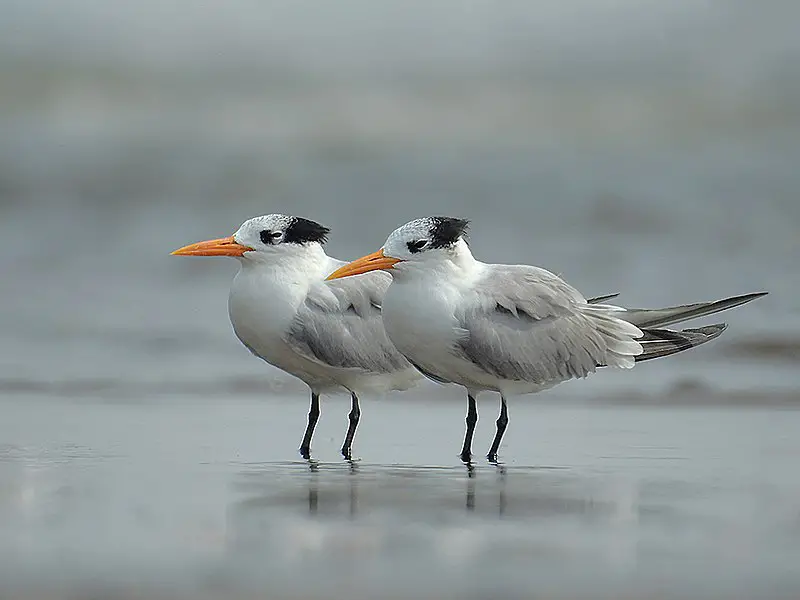
The lesser crested tern is a beautiful bird belonging to the Laridae family. It can be found breeding in subtropical coastal parts of the world, mainly from Red Sea across Indian Ocean.
Its genus name comes from Ancient Greek word Thalasseus which means fisherman and its specific bengalensis refers to Bengal, historically referring to much of northern India and Bangladesh.
The adult has white plumage with grey on wings and back; black cap extending behind eye; long pointed bill yellow tipped red at base, orange legs and feet.
They feed primarily by plunge-diving for fish near shore but may also take some insects or scavenge off boats or piers when given opportunity.
This species nests in colonies often on beaches or islands with other seabirds where it lays two eggs per clutch that are incubated for about a month before hatching.Scientific classification:
| Kingdom | Animalia |
| Phylum | Chordata |
| Class | Aves |
| Order | Charadriiformes |
| Family | Laridae |
| Genus | Thalasseus |
| Species | T. bengalensis |
10. Crab-Plover
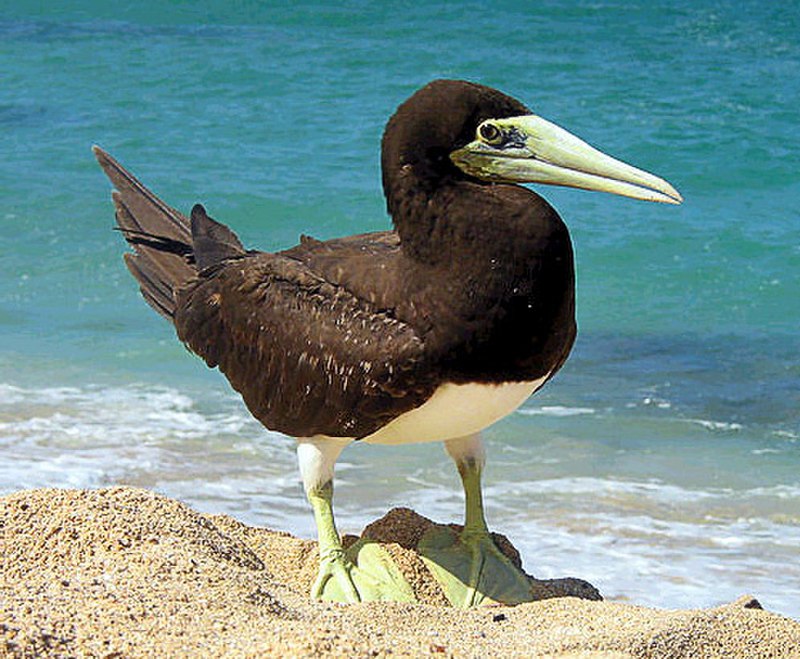
The crab-plover is an exceptional bird which belongs to its own family, Dromadidae. It appears to be closely related to the waders and other Charadriiformes such as auks, gulls and thick-knees.
This species of bird has a unique look; it is white with black markings on its head and wings. Its long bill helps them dig for food in sand or mudflats.
They can also fly up into the air when disturbed by predators or people too close for comfort.
The crab plover spends most of its life near beaches where they feed on crabs, fish eggs and small insects found there.
These birds are highly social during breeding season but solitary at other times throughout their annual cycle making them difficult creatures to spot out in the wild but well worth trying.Scientific classification:
| Kingdom | Animalia |
| Phylum | Chordata |
| Class | Aves |
| Order | Charadriiformes |
| Suborder | Lari |
| Family | Dromadidae GR Gray, 1840 |
| Genus | Dromas Paykull, 1805 |
| Species | D. ardeola |
11. Caspian Plover
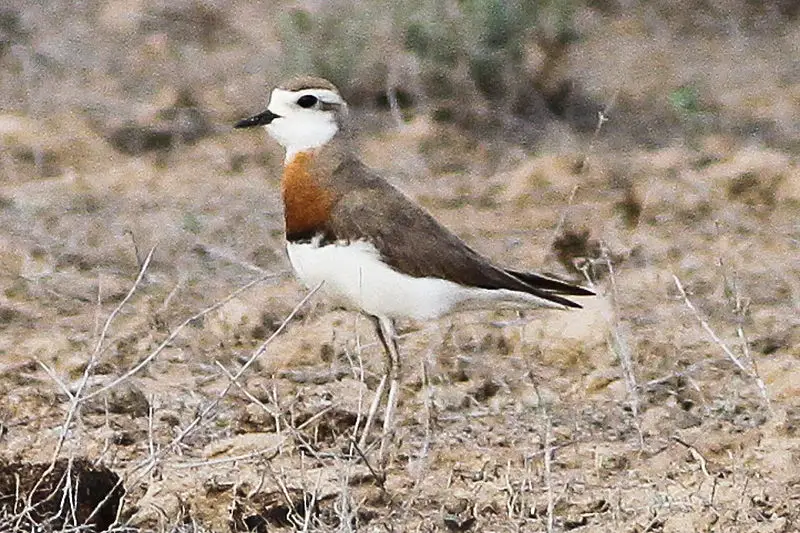
The Caspian plover is a species of wader belonging to the plover family of birds. It has an apt scientific name as ‘Charadrius’ meaning yellowish bird and ‘asiaticus’ referring to its Asian range.
These birds are found in ravines, river valleys or coastal mudflats with their diet primarily consisting of insects, crustaceans and worms.
They breed once every year producing 4-5 eggs which they incubate for around 25 days before hatching into chicks that fledge after another couple weeks.
The IUCN Red List classifies them as Vulnerable due to human activities like hunting and wetland reclamation leading to habitat destruction causing population decline over time.
Conservation efforts need be undertaken soon in order ensure survival of this beautiful species.Scientific classification:
| Kingdom | Animalia |
| Phylum | Chordata |
| Class | Aves |
| Order | Charadriiformes |
| Family | Charadriidae |
| Genus | Charadrius |
| Species | C. asiaticus |
Also Featured In: Birds of Etosha National Park,
12. Cotton Pygmy Goose
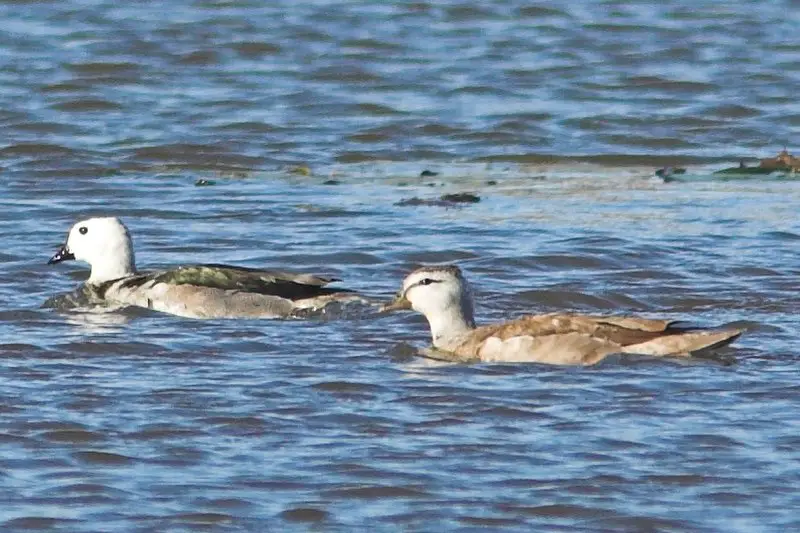
The Cotton Pygmy Goose is a small perching duck found throughout Asia and Southeast Asia, extending south to Queensland.
It stands out among waterfowl as one of the smallest in the world, with a quill-white coloration that helps it blend into its environment.
They often live alone or in pairs but form larger groups when looking for food near bodies of water with plenty of aquatic vegetation.
These birds are omnivorous, feeding on plants like grasses and seeds alongside insects such as beetles and termites.
Their diet also includes fish eggs and larvae from time to time. The cotton pygmies’ size makes them an easy target for predators so they use their agility to quickly escape danger whenever possible.Scientific classification:
| Kingdom | Animalia |
| Phylum | Chordata |
| Class | Aves |
| Order | Anseriformes |
| Family | Anatidae |
| Genus | Nettapus |
| Species | N. coromandelianus |
13. Namaqua Dove
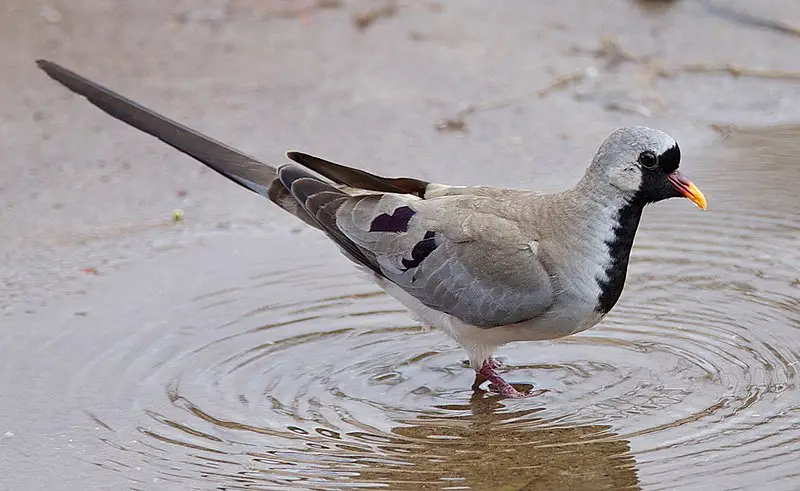
The Namaqua dove is a small pigeon that inhabits much of Sub-Saharan Africa, as well as Arabia and Madagascar.
It is the only species in its genus Oena, which has close affinities with the doves from Turtur.
Described for science by French zoologist Mathurin Jacques Brisson back in 1760, it typically measures between 26 to 28 cm long and boasts distinctive reddish plumage on its head, neck and breast region.
Its diet consists mainly of grains such as millet or wheat; however they may also feed on insects during dry spells when food sources are scarce.
The population size remains stable overall but localised declines have been observed due to human activities like habitat destruction and hunting for subsistence use or sport purposes.Scientific classification:
| Kingdom | Animalia |
| Phylum | Chordata |
| Class | Aves |
| Order | Columbiformes |
| Family | Columbidae |
| Genus | Oena Swainson, 1837 |
| Species | O. capensis |
14. Chestnut-Bellied Sandgrouse
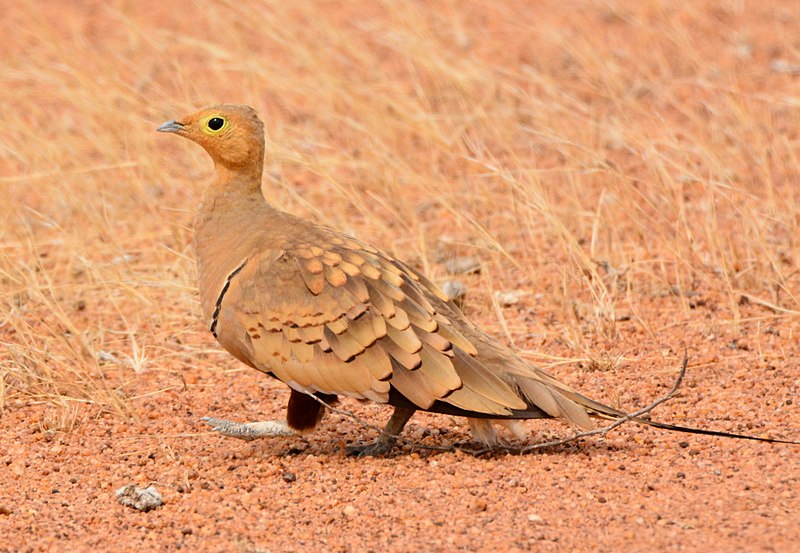
The Chestnut-bellied sandgrouse is a species of bird found in northern and central Africa, as well as western and southern Asia.
It has six recognised subspecies which differ in plumage colouration; males typically have mostly light buffy brown feathers with darker bars on the wings, while females are greyer with paler head markings.
These birds prefer semi-arid regions such as deserts or grasslands where they eat seeds from plants like grasses, herbs and shrubs.
They can be nomadic depending on food availability but tend to be sedentary during mating season when they form small groups called leks for courtship displays involving intricate feather ruffling and strutting around potential mates.
The Chestnut-bellied Sandgrouse is an important part of its native ecosystems due to their role in dispersing plant seeds over large areas through defecating them after ingestion.Scientific classification:
| Kingdom | Animalia |
| Phylum | Chordata |
| Class | Aves |
| Order | Pterocliformes |
| Family | Pteroclidae |
| Genus | Pterocles |
| Species | P. exustus |
15. Sandgrouse
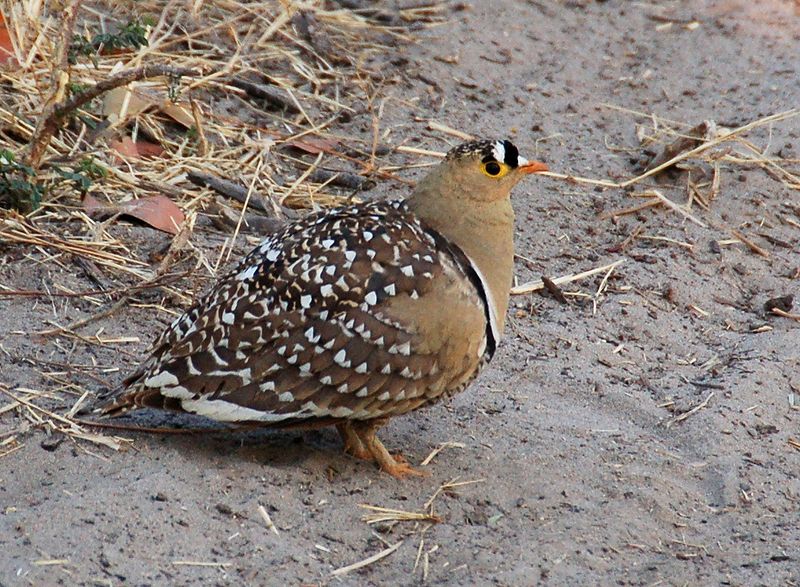
Sandgrouse is birds of the order Pterocliformes, found mainly in Africa and Asia. There are sixteen species belonging to two genera – Syrrhaptes from central Asia and Pterocles from Africa and other Asian countries.
They inhabit treeless areas such as deserts, steppes, scrubland, or savannas and tend to be ground-dwelling birds that feed on seeds.
Sandgrouse has adapted special features for survival in their harsh environment.
They possess well-developed feet with four toes used for walking over hot sand while keeping their body temperature cool at all times by regulating heat loss through their legs.
Their feathers also act like a sponge helping them absorb water before flying long distances back home where they then expel it using specialized glandular secretions located near the wings so that chicks can drink directly from an adult’s breast plumage.Scientific classification:
| Kingdom | Animalia |
| Phylum | Chordata |
| Class | Aves |
| Clade | Columbimorphae |
| Order | Pterocliformes Huxley, 1868 |
| Family | Pteroclidae Bonaparte, 1831 |
16. Painted-Snipe
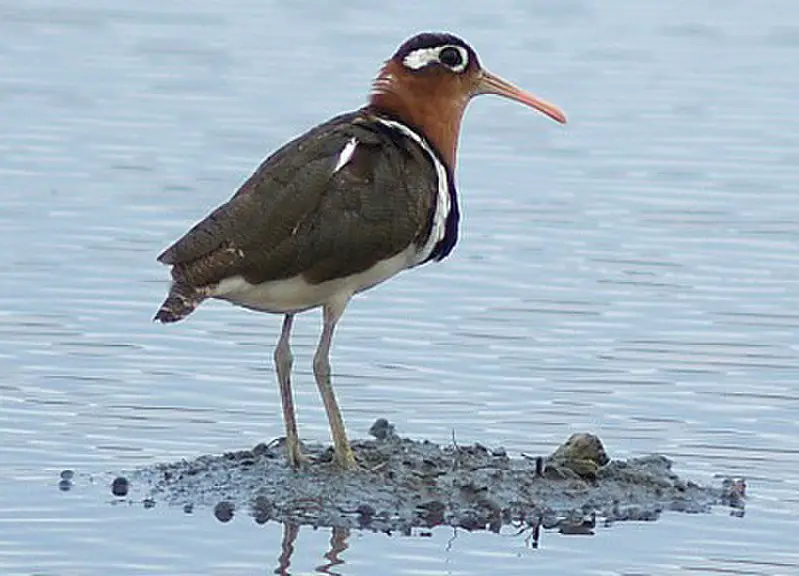
Painted snipes are beautiful and unique wading birds found in the Rostratulidae family. They have short legs, long bills, and a striking plumage which distinguishes them from true snipes.
Males tend to be smaller than females with duller overall coloration. There are three species of painted snipe.
The Greater Painted Snipe, Lesser Painted Snipe, and Australian Painted Snipe – all three have different habitats ranging from wetland pools to grasslands or mangroves depending on their region.
These birds feed mainly on earthworms but also consume insects, crustaceans and plant material when available.
As they rely heavily on wetlands for breeding purposes it is important that we protect these precious habitats so that this special bird can continue to thrive.Scientific classification:
| Kingdom | Animalia |
| Phylum | Chordata |
| Class | Aves |
| Order | Charadriiformes |
| Suborder | Thinocori |
| Family | Rostratulidae Coues, 1888 |
17. Stone-Curlew

Stone-curlews, also known as dikkops or thick-knees, are a family of birds that have adapted to live in tropical and temperate regions throughout the world.
They can be found in Africa, Asia and Australia with two or more species per region. Despite being classified as waders, most prefer dry arid habitats over moist wetlands.
Stone-curlews typically have long legs which help them navigate through their preferred terrain efficiently; some species even stand at an impressive height when standing on those long legs.
Additionally they feature cryptic plumage which helps them blend into their surroundings while hunting for prey such as insects and small mammals like rodents.
These unique bird’s calls are easily recognizable; it has been said that hearing one is similar to listening to someone whistling ‘Keee Weee’.Scientific classification:
| Kingdom | Animalia |
| Phylum | Chordata |
| Class | Aves |
| Order | Charadriiformes |
| Suborder | Chionidi |
| Family | Burhinidae Mathews, 1912 |
18. Black-Winged Pratincole
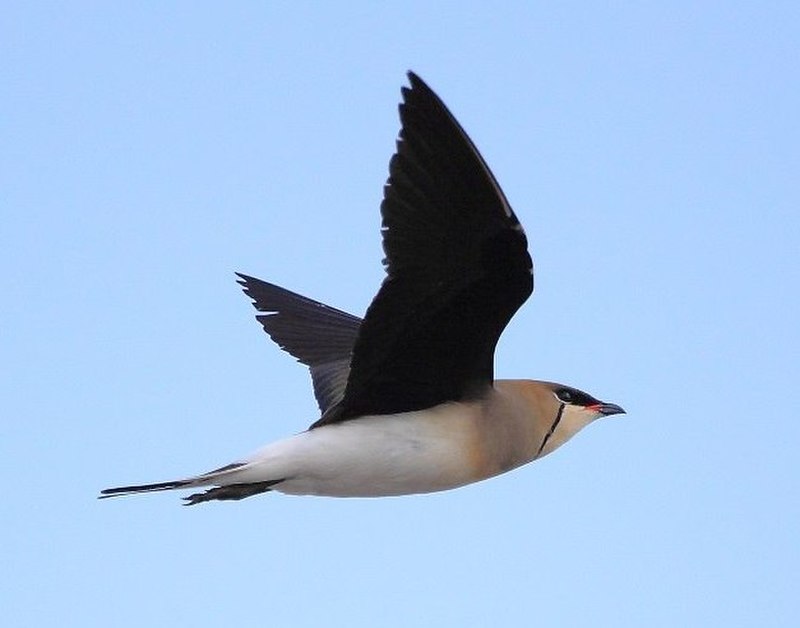
The Black-winged Pratincole is a wader belonging to the Glareolidae family. It measures about 24 – 28 cm in length and has short legs, long pointed wings, as well as a forked tail.
This species was named after Finnish zoologist Alexander von Nordmann and nests in gravel habitats.
Its diet consists of insects which it catches on the wing while flying low over fields or water surfaces with rapid beating wings.
During breeding season it exhibits an extraordinary courtship flight accompanied by singing noises usually above its nesting grounds where they often breed in colonies together with other pratincoles or lapwings.
The black-winged pratincole also migrates great distances during winter months spending time primarily around Africa’s Mediterranean coastlines before heading back northwards when Spring arrives again.Scientific classification:
| Kingdom | Animalia |
| Phylum | Chordata |
| Class | Aves |
| Order | Charadriiformes |
| Family | Glareolidae |
| Genus | Glareola |
| Species | G. nordmanni |
Also Featured In: Belarus Birds You Should Know,
19. Jacanas
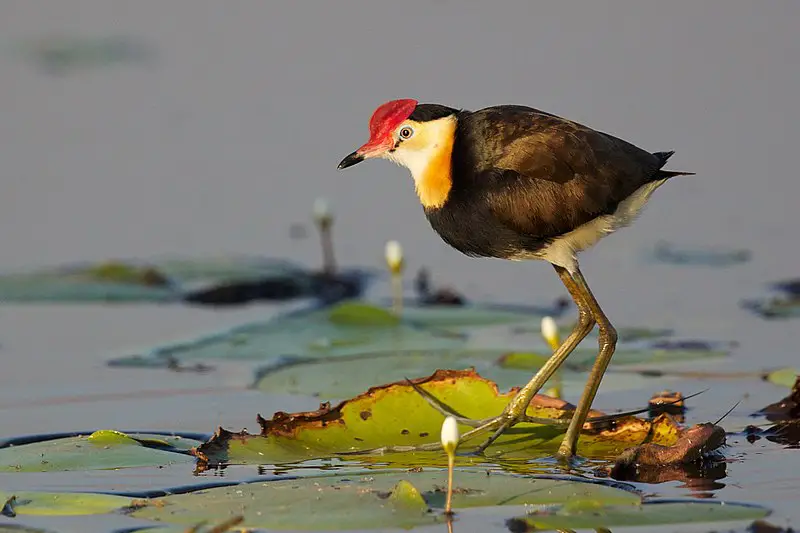
Jacanas are tropical waders belonging to the Jacanidae family. They have distinctive elongated toes and toenails which help them forage on floating or semi-emergent aquatic vegetation.
This adaptation gives them their nickname “Jesus birds” as they seem to be able to walk on water.
The female jacanas are also unique amongst bird species in that they take charge of nest building, incubation and caring for young while males perform courtship displays.
These unusual birds can be found throughout the world’s tropical regions where they inhabit wetlands such as swamps, marshes and shallow lakes with lily pads.
With a wide variety range due their special adaptations these beautiful creatures will surely continue living life at ease around our planet’s warmest waters.Scientific classification:
| Kingdom | Animalia |
| Phylum | Chordata |
| Class | Aves |
| Order | Charadriiformes |
| Suborder | Thinocori |
| Family | Jacanidae Stejneger, 1885 |
20. Crowned Sandgrouse
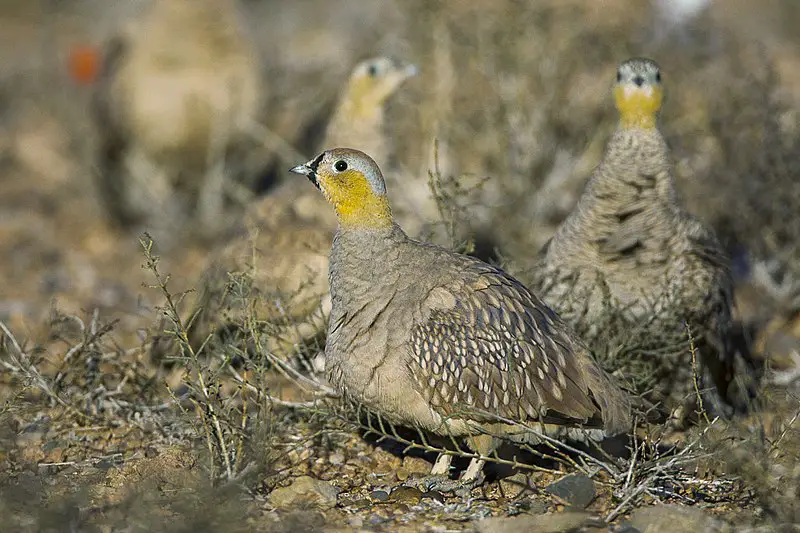
The crowned sandgrouse is a small bird with little features that can easily be distinguished from other sandgrouses. It has an overall uniform colouration, except for its darker flight feathers which are the best way to identify it.
This species of bird resides in North Africa and the Middle East, living on sandy soils where they feed mainly on seeds and insects.
During mating season males will puff up their chest feathers to form a crown-like feature as part of courtship displays – hence the name ‘crowned’.
The female will lay her eggs directly onto bare ground or sometimes into shallow scrapes so that there’s no nest structure built by either parent birds.
Crowned sandgrouses have adapted well to arid environments due to their ability to store water within specialized feathers found near their belly area — allowing them access during times when surface water sources are scarce.Scientific classification:
| Kingdom | Animalia |
| Phylum | Chordata |
| Class | Aves |
| Order | Pterocliformes |
| Family | Pteroclidae |
| Genus | Pterocles |
| Species | P. coronatus |
21. Armenian Gull
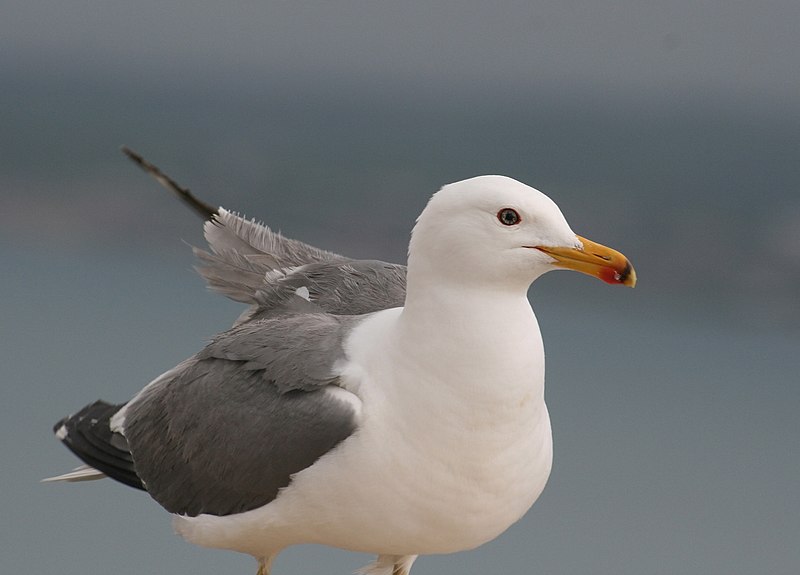
The Armenian gull is a large species of seabird found in the Caucasus and Middle East. It was previously classified as a subspecies of the European herring gull, but has now been recognised as its own separate species by BirdLife International.
On average, it measures around 48-56 cm long with an impressive wingspan up to 130cm wide. This bird typically has light grey upperparts, white underparts and black legs contrasted with yellow feet.
One interesting feature are its reddish eyes which makes them easily identifiable from other similar looking birds such as Yellow Legged Gulls or Herring Gulls.
They feed mainly on insects, fish and molluscs near coastal areas or inland wetlands during their breeding season between April – August each year when they lay 2-3 eggs in nests made out of sticks & twigs lined with grasses & feathers for insulation against extreme weather conditions.Scientific classification:
| Kingdom | Animalia |
| Phylum | Chordata |
| Class | Aves |
| Order | Charadriiformes |
| Family | Laridae |
| Genus | Larus |
| Species | L. armenicus |
22. Falcon
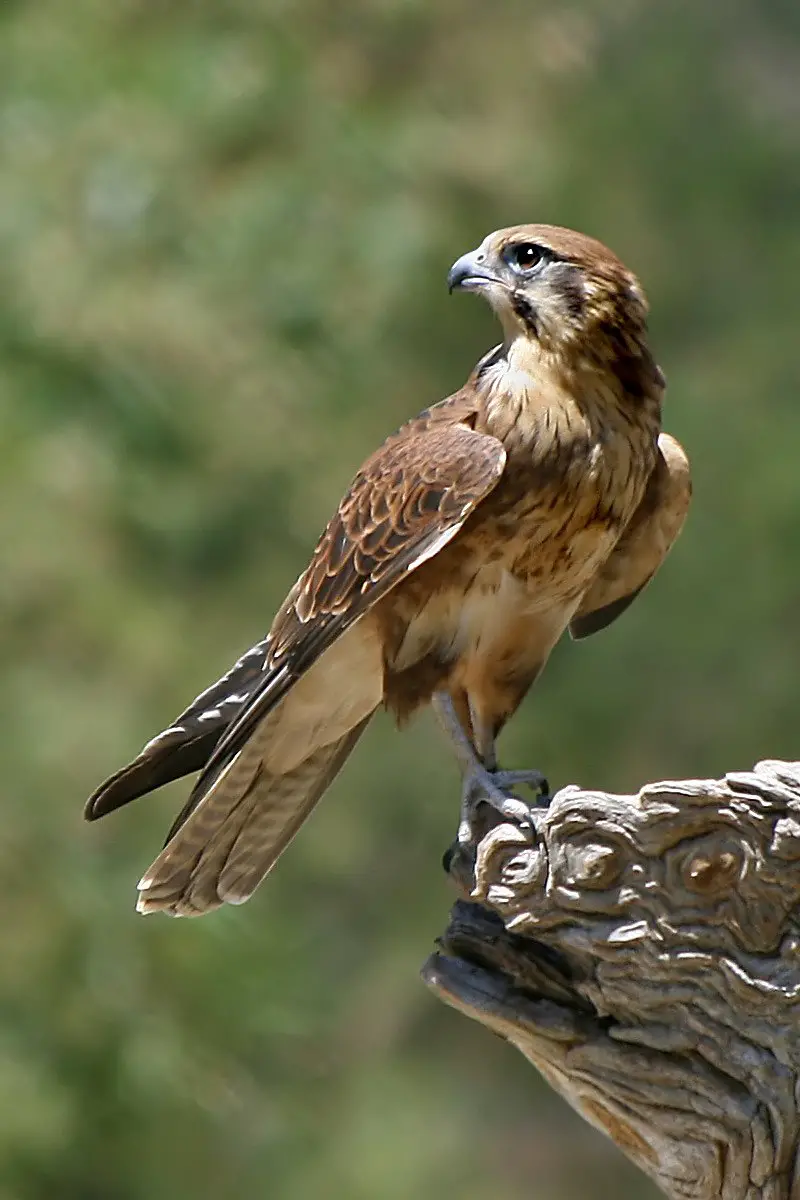
Falcons are majestic birds of prey found in almost all parts of the world, except Antarctica. They have long, slender wings that allow them to fly swiftly and change directions quickly.
As adults they feed on small animals such as mice and insects, but when young their diet consists mainly of carrion or food provided by their parents.
Falcons use a range of techniques for hunting including hovering high up above potential prey before diving down at great speed to catch it during flight.
Additionally they also ambush unsuspecting victims from concealed perches close to the ground.
These remarkable hunters can even take advantage of thermal currents rising off warm surfaces like roads which give them an extra boost while flying.Scientific classification:
| Kingdom | Animalia |
| Phylum | Chordata |
| Class | Aves |
| Order | Falconiformes |
| Family | Falconidae |
| Subfamily | Falconinae |
| Genus | Falco Linnaeus, 1758 |
23. Western Reef Heron
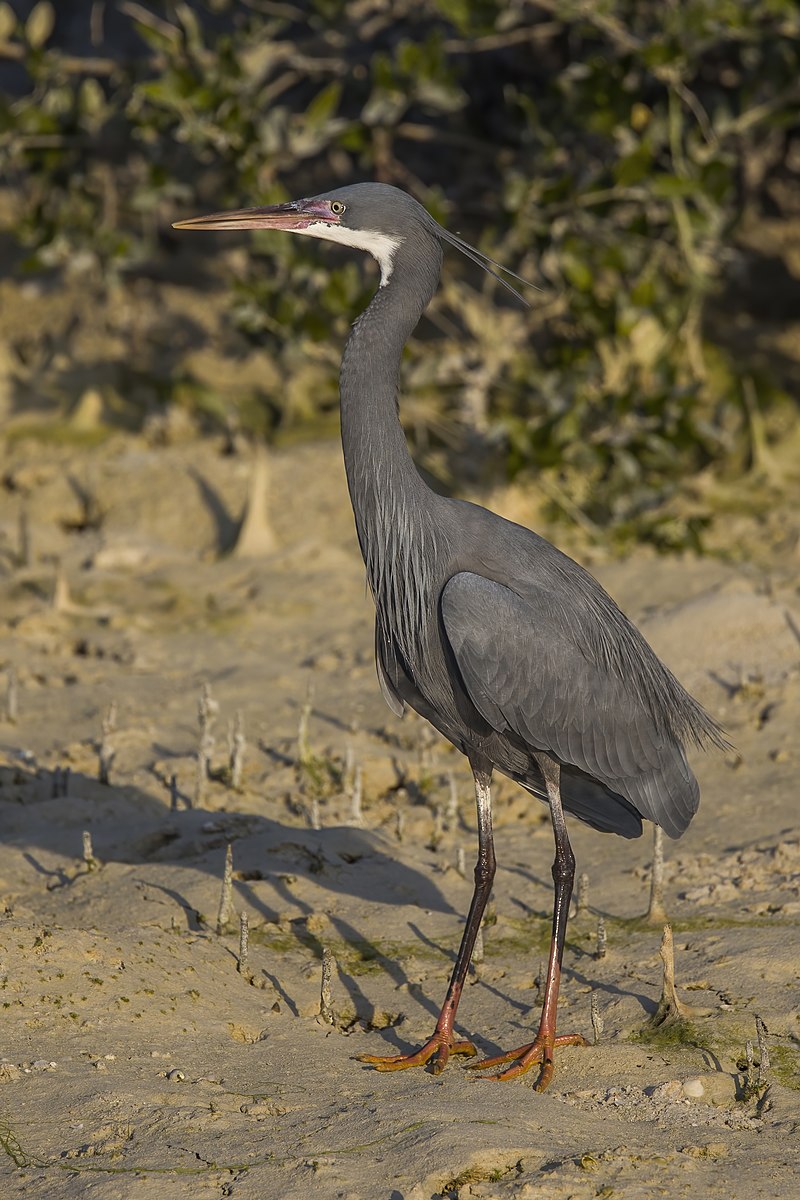
The western reef heron, also known as the western reef egret, is a medium-sized bird found in southern Europe, Africa and some parts of Asia. It usually inhabits coastal areas and has two distinctive plumage forms.
The slaty-grey form can be mistaken for the rare dark morph of the Little Egret while its white form looks similar to that of an immature Grey Heron.
This species feeds mainly on fish but will occasionally eat insects or other small aquatic animals like crabs and molluscs too.
Western Reef Herons are solitary birds that nest near water bodies where they build nests from sticks which may sometimes contain feathers or seaweed as well.
They have become endangered since their habitats have been destroyed due to human activities such as building developments along coastlines; however conservation efforts are being taken to ensure their survival into future generations.Scientific classification:
| Kingdom | Animalia |
| Phylum | Chordata |
| Class | Aves |
| Order | Pelecaniformes |
| Family | Ardeidae |
| Genus | Egretta |
| Species | E. gularis |